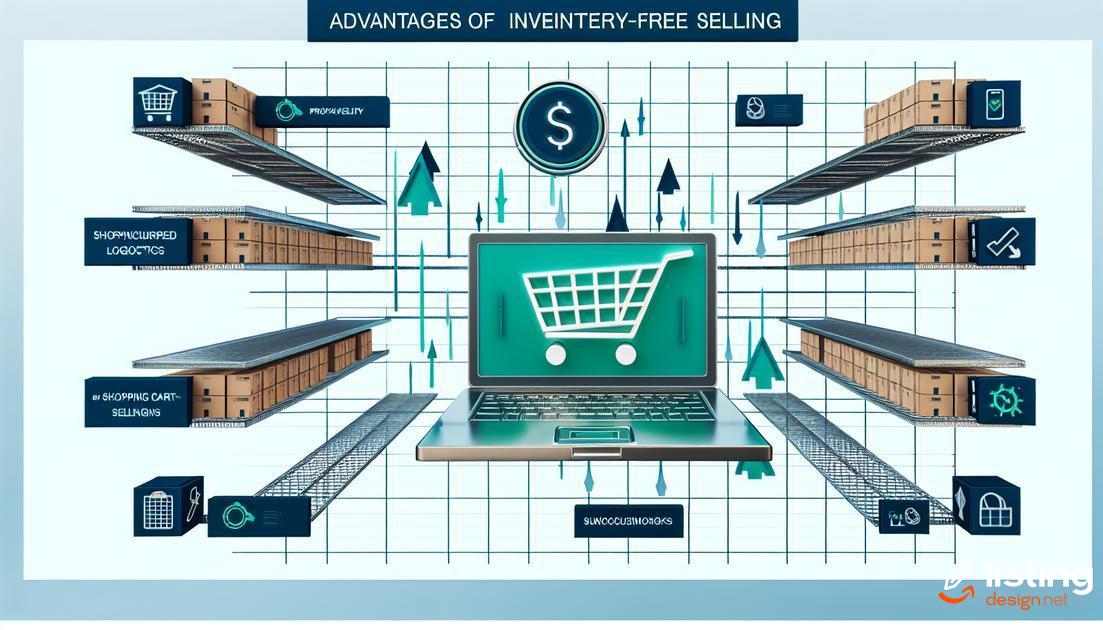Discover the world of inventory-free selling on Amazon, where you can maximize profit potential without the burden of managing stock. This business model allows sellers to leverage dropshipping and other techniques to offer products without holding inventory. Dive into the advantages, challenges, and essential strategies needed to succeed, and learn how to get started effectively.
Table of Contents
Understanding Inventory-Free Selling
Inventory-free selling allows you to offer products for sale without holding any physical stock. It leverages models like dropshipping and print-on-demand, where suppliers ship products directly to customers.
Drop Shipping Model
In the dropshipping model, you act as a middleman between the customer and the supplier. When a customer places an order, you forward it to your supplier who then ships the product directly to the customer. This means you never handle the inventory.
Print-on-Demand
Print-on-demand is another form of inventory-free selling where products are only created once an order is placed. This is often used for custom items like t-shirts, mugs, and posters, and is fulfilled by a third-party service provider.
Advantages
Inventory-free selling minimizes investment risk because you’re not purchasing stock upfront. It also offers the flexibility to test various products without the commitment of buying in bulk.
Advantages of Inventory-Free Selling
Reduced Upfront Costs
One of the key benefits of inventory-free selling is the significant reduction in upfront costs. Sellers can avoid expenses related to purchasing stock, warehousing, and managing inventory. This allows for more flexibility in budgeting and financial planning.
Minimized Risk
With no need to hold large quantities of stock, sellers are less exposed to risks associated with unsold inventory or market fluctuations. This approach ensures that businesses can adapt quickly to changes without financial strain.
Operational Efficiency
By removing the complexities of inventory management, sellers can streamline their operations and focus on core business activities such as marketing, sales, and customer service. This leads to increased efficiency and the potential for higher profits.
Scalability
Inventory-free models allow for easier scaling of the business. Since there is no need to manage larger physical stocks, businesses can expand their product offerings and reach new markets with less effort and investment.
Environmental Impact
By not holding physical inventory, sellers contribute to a reduction in waste and overproduction. This environmentally friendly approach aligns with sustainable business practices and can appeal to eco-conscious consumers.
Flexibility
Sellers can quickly respond to market trends and consumer demand without the constraints of existing inventory. This flexibility enables businesses to stay relevant and competitive in a constantly evolving market.
Vendor Relationships
Inventory-free selling often involves building strong relationships with suppliers and manufacturers. These partnerships can lead to better terms, exclusive products, and reliable supply chains, further enhancing the business’s stability and growth potential.
Challenges of Inventory-Free Selling
Running an inventory-free selling business isn’t without its hurdles. One significant challenge is maintaining supplier reliability. When you depend solely on suppliers to fulfill orders, any stock issues on their end directly affect your customer satisfaction and business reputation.
Another critical issue is quality control. Without handling the products yourself, ensuring they’re up to your standards can be tricky. Supplier verification methods and sample ordering become essential practices to minimize the risks of poor quality or defective products reaching your customers.
Shipping times and costs can also be a constraint. Delays in delivery and higher shipping costs can result in negative reviews and lower profit margins. It’s crucial to communicate clearly with your suppliers and establish reliable shipping procedures to mitigate these issues.
Another obstacle can be inventory management. Although you are not stocking products, you still need to keep track of inventory levels with your suppliers to avoid overselling or running out of stock. Employing inventory management tools can help keep this process streamlined and efficient.
Lastly, dealing with returns and customer service can become complicated. Without physical stock, processing returns often requires coordinating with suppliers, which can lengthen return periods and frustrate customers. Developing a robust return policy and having a clear customer service protocol is essential to handle these situations smoothly.
How to Get Started
Getting started with inventory-free selling on Amazon involves several steps. Firstly, you need to understand Amazon’s Fulfillment by Amazon (FBA) program and how it can facilitate your venture without the need to hold physical inventory.
Step 1: Create a professional Amazon seller account. This will open up various tools and metrics to track your performance.
Step 2: Research and choose reputable suppliers who offer dropshipping services. Ensure they have a proven track record and can meet Amazon’s quality and delivery standards.
Step 3: List your products on Amazon. Write detailed product descriptions and use high-quality images to attract potential buyers.
Step 4: Understand Amazon’s policies and guidelines to ensure your listings remain compliant. Regularly update your listings based on available stock and supplier information.
Step 5: Optimize your product listings using relevant keywords, and ensure your products are correctly categorized to maximize visibility.
Step 6: Monitor your sales and adjust your strategies as needed. Utilize Amazon’s Seller Central dashboard to keep track of your metrics and performance.
Step 7: Engage with customer reviews and feedback. Address any issues promptly to maintain a high seller rating and positive customer experience.
Essential Tools and Platforms
When diving into the world of inventory-free selling on Amazon, leveraging the right tools and platforms is critical for success. One of the most invaluable tools is Amazon Seller Central. This platform serves as the primary interface where you manage your listings, track sales, and handle customer inquiries.
Third-party services like Shopify can seamlessly integrate with Amazon, enabling you to manage multiple sales channels from a single dashboard. This is especially useful for those who wish to diversify their eCommerce presence beyond Amazon.
Inventory management software like InventoryLab or Sellbrite can automate stock tracking, even if your stock is essentially virtual. These tools help prevent overselling and allow you to keep tabs on different supplier timelines.
PPC management tools such as Sellics or Jungle Scout provide data-driven insights into your advertising campaigns. They help optimize your keyword bidding strategies to increase visibility and boost sales.
Customer relationship management (CRM) platforms like HubSpot or Zoho enable sellers to manage and nurture customer relationships effectively. Even in an inventory-free model, maintaining strong customer relationships is vital for repeat business and positive reviews.
Financial management tools like QuickBooks or Xero are also crucial. These platforms help you keep track of your finances, allowing for accurate bookkeeping and financial planning. Understanding your cash flow, expenses, and profitability will enable you to make more informed business decisions.
By using these essential tools and platforms, you can streamline your operations, enhance efficiency, and focus more on growth strategies for your inventory-free Amazon business.
Choosing the Right Products
When selling on Amazon without holding inventory, selecting the right products is crucial to your success. To start, it’s important to focus on high-demand and low-competition items. Conducting thorough research can help identify these products.
Utilize tools like Amazon’s Best Sellers list and keyword research platforms to understand current market trends. These resources can provide insights into what customers are searching for the most.
Additionally, consider the profit margins of the products. Items with higher margins can increase your overall profitability. Look for suppliers or drop shipping partners who offer competitive pricing without compromising on quality.
Keep in mind the size and weight of the products as well. Lightweight, smaller items generally incur lower shipping costs, making them more cost-effective to sell.
Lastly, always keep an eye on product reviews and ratings. They can help you gauge customer satisfaction and potential return rates, both of which are vital for maintaining a positive seller rating on Amazon.
Building Vendor Relationships
Fostering strong vendor relationships is essential for a successful inventory-free selling strategy on Amazon. These relationships can provide a competitive edge, consistent product quality, and timely deliveries. Here are some key steps to build and maintain robust relationships with your vendors.
1. Clearly Communicate Your Expectations
Start by setting clear expectations with your vendors. Discuss important aspects such as product quality, shipping timelines, return policies, and pricing structures. Written agreements can formalize these expectations, reducing misunderstandings and reinforcing commitment.
2. Build Trust Through Transparency
Trust is the foundation of any successful vendor relationship. Share your business goals, be honest about your needs, and consistently meet your obligations. This transparency helps create a strong partnership where both parties can flourish.
3. Foster Continuous Communication
Maintain regular communication with your vendors to ensure all operations run smoothly. This includes updating them on changes in demand, addressing any issues immediately, and seeking feedback to improve the workflow. Tools like email, chat apps, and scheduled meetings can facilitate ongoing dialogue.
4. Recognize and Appreciate Your Vendors
Show your appreciation for your vendors’ work by acknowledging their efforts and providing positive feedback. This can motivate them to continue providing high-quality service, enhance their loyalty, and strengthen your business relationship.
5. Leverage Technology for Better Management
Utilize tools such as Vendor Relationship Management (VRM) software to streamline communication, track performance, and eliminate bottlenecks. Technology can automate many aspects of working with vendors and ensure a seamless partnership.
Price Optimization Strategies
Dynamic Pricing: Monitor market trends and competitor prices in real-time to adjust your prices accordingly. Use dynamic pricing tools to automate this process and stay competitive.
Price Testing: Experiment with different price points to determine the optimal price that maximizes both sales and profits. Use A/B testing methods to analyze customer reactions to different pricing structures.
Bundle Pricing: Offer product bundles at a discounted rate compared to purchasing items individually. This strategy can increase the perceived value and encourage customers to buy more.
Seasonal Pricing: Adjust your prices based on seasonal demand. For instance, raise prices during high-demand seasons and lower them during off-peak times to boost sales.
Psychological Pricing: Implement pricing strategies that appeal to customer psychology. For example, pricing a product at $19.99 instead of $20 can make it seem more affordable.
Competitor Analysis: Regularly analyze competitor pricing strategies to identify gaps and opportunities. Position your prices strategically to offer better value without compromising your profit margins.
Cost-Plus Pricing: Calculate your total costs and add a markup to ensure profitability. This straightforward method helps cover all expenses while ensuring a profit margin.
Discount Strategies: Use discounts strategically to attract customers. Limited-time offers or flash sales can create urgency and drive quick sales.
Subscription Pricing: If applicable, offer subscription-based pricing models to ensure recurring revenue. This can also enhance customer loyalty and lifetime value.
Geographical Pricing: Adjust prices based on geographical location and purchasing power. This strategy can help cater to different markets more effectively.
Customer Segmentation: Segment your customers based on their purchasing behavior and tailor pricing strategies accordingly. Offering personalized pricing can enhance customer satisfaction and loyalty.
Marketing Your Products
Leverage Social Media
Utilize platforms like Facebook, Instagram, and Pinterest to showcase your products and engage with potential customers. Create visually appealing posts, stories, and ads to attract attention and drive traffic to your Amazon listings.
Influencer Collaborations
Partner with influencers in your niche to reach a broader audience. Influencers can create authentic content that resonates with their followers, increasing your product’s visibility and credibility.
Optimize Amazon Listings
Ensure your product titles, descriptions, and bullet points are rich with relevant keywords. High-quality images and detailed product information can significantly enhance your listing’s appeal and search rankings.
Amazon Advertising
Utilize Amazon’s PPC (Pay-Per-Click) campaigns to boost the visibility of your products. Sponsored Product Ads and Sponsored Brand Ads can drive targeted traffic to your listings, leading to higher sales.
Email Marketing
Build an email list of interested customers and send regular updates about new products, promotions, and valuable content. This keeps your audience engaged and encourages repeat purchases.
Leveraging Customer Reviews
Encourage satisfied customers to leave positive reviews. High ratings and positive feedback can significantly impact your product’s credibility and ranking on Amazon.
SEO Best Practices
Implement SEO strategies in your product listings and marketing content. Use relevant keywords naturally to improve your visibility in search results both on Amazon and in search engines like Google.
Handling Customer Service
Efficient customer service is key to maintaining a strong relationship with your buyers and ensuring repeat business. Addressing customer queries promptly, resolving issues quickly, and maintaining a professional demeanor are essential components of good customer service.
Responding to Inquiries: Always respond to customer inquiries within 24 hours. Use clear, concise language and a friendly tone. Make use of Amazon’s messaging system to ensure all communication is properly tracked.
Managing Feedback and Reviews: Monitor feedback and reviews regularly. Address any negative feedback professionally. Apologize for any inconvenience caused and offer solutions to resolve the issue.
Return and Refund Policies: Clearly outline your return and refund policies. Ensure they are fair and easy to understand. Process refunds swiftly to maintain customer trust.
Using CRM Tools: Utilize Customer Relationship Management (CRM) tools to track customer interactions and feedback. These tools help in streamlining communication and improving overall customer service efficiency.
Training Your Team: If you have a team handling customer service, invest in proper training. Ensure they understand your policies and are equipped to handle various customer scenarios.
Personalization: Where possible, personalize your interactions. Address your customers by their names and reference their recent purchases. This personal touch can significantly improve customer satisfaction.
Measuring Success
One of the crucial elements in determining the profitability and efficiency of your inventory-free selling model on Amazon is by effectively measuring success. Utilize a range of metrics and key performance indicators (KPIs) to track performance over time. Some essential metrics to consider include:
Sales Revenue:
Track your total sales revenue over specified periods to gauge overall business performance. It’s important to compare these figures against previous months or quarters to identify growth patterns.
Conversion Rate:
The percentage of visitors who make a purchase is a critical indicator of your sales effectiveness. This metric helps in understanding the appeal of your product listings and the efficiency of your sales funnel.
Customer Acquisition Cost (CAC):
Measure the cost associated with acquiring a new customer. Keeping this cost low while maintaining high-quality customer acquisition is a key to long-term profitability.
Return on Investment (ROI):
Assess the profitability of your marketing and selling efforts by calculating the ROI. This involves comparing the profit generated from sales against the costs incurred in marketing and operations.
Customer Lifetime Value (CLV):
Understanding the total value a customer brings to your business over their lifetime can help in planning long-term strategies and allocating resources effectively.
Feedback and Reviews:
Regularly monitor customer feedback and reviews to gauge satisfaction and identify areas for improvement. Positive feedback can boost your credibility, while negative reviews should be addressed promptly to maintain your reputation.
Order Fulfillment Time:
Track how long it takes to fulfill orders. Efficient order processing can lead to higher customer satisfaction and repeat purchases.
By focusing on these metrics, you can gain a comprehensive view of your business’s health and make informed decisions to drive growth and scalability.
Scaling Your Business
Optimizing Operations
When your Amazon business begins to grow, it’s crucial to streamline your operations. Evaluate your processes and identify areas where you can automate or delegate tasks. Essential tools and platforms can drastically improve efficiency, saving you both time and money.
Increase Vendor Partnerships
Expanding your network of reliable vendors is key to scaling. Build strong relationships with multiple suppliers to ensure a steady supply of products. Utilize strategies for effective communication and negotiation to secure the best deals.
Leverage Data Analytics
Utilize data analytics tools to track your performance and make informed decisions. Analyze sales data, customer behavior, and market trends to identify growth opportunities. Implementing data-driven strategies will help you stay ahead of the competition.
Expand Product Lines
Diversifying your product offerings can attract a wider customer base. Research new niches and trends, and gradually introduce new products. Ensure that each addition aligns with your brand and adds value to your customers.
Invest in Marketing
Increase your marketing efforts to reach a broader audience. Enhance your social media presence, invest in PPC campaigns, and collaborate with influencers. A robust marketing strategy can exponentially grow your customer base and boost sales.
Efficient Customer Service
As your business scales, maintaining high-quality customer service is paramount. Implement systems to handle increased inquiries and returns efficiently. Prioritize customer satisfaction to build loyalty and facilitate repeat purchases.
Monitor Cash Flow
Scaling requires significant investment, so keep a close eye on your financials. Implement budgeting and financial planning to manage your cash flow effectively. Seek out financing options if necessary to support your growth initiatives.








